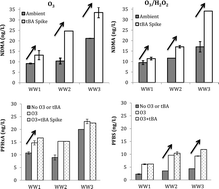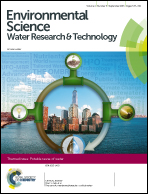Effects of molecular ozone and hydroxyl radical on formation of N-nitrosamines and perfluoroalkyl acids during ozonation of treated wastewaters†
Abstract
N-Nitrosamines—toxic disinfection byproducts commonly associated with chloramination—have recently been shown to increase after ozonation of some surface waters and treated wastewaters. In addition to five nitrosamines, two perfluoroalkyl acids (PFAAs) are included in the most recent U.S. EPA Contaminant Candidate List due to potential public health risks. In this manuscript, the potential roles of molecular ozone (O3) and hydroxyl radical (˙OH) were investigated in the formation of N-nitrosamines and PFAAs in treated wastewaters. The results herein are based on controlled bench-scale experiments designed to isolate the effects of O3 with the use of t-butanol as a ˙OH scavenger. Nitrous oxide gas saturated samples were exposed to gamma radiation to isolate the effects of ˙OH, and para-chlorobenzoic acid was used to assess ˙OH exposure. This study found that the presence of molecular ozone versus the hydroxyl radical promoted N-nitrosodimethylamine (NDMA) formation. Six other N-nitrosamines showed very little or no formation upon the ozonation of six treated wastewaters up to an O3 : TOC ratio of 1.0. For PFAAs, perfluorohexanoic acid (PFHxA) formed the highest and most consistently upon ozonation (up to an O3 : TOC ratio of 2.0) of the same six treated wastewaters. Presence of molecular ozone (more so than hydroxyl radical), appears to promote the formation of PFHxA and perfluorobutane sulfonic acid (PFBS). The effect of pH in the range of 6–8 upon the formation of NDMA and PFAAs was found to be minimal. These findings provide new understanding of the formation of oxidation byproducts during ozonation of reclaimed wastewaters. Depending on future regulatory determinations, NDMA and a few PFAAs could be of concern for potable reuse treatment systems that employ ozone.

- This article is part of the themed collection: Potable Reuse of Water

 Please wait while we load your content...
Please wait while we load your content...